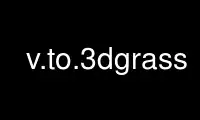
This is the command v.to.3dgrass that can be run in the OnWorks free hosting provider using one of our multiple free online workstations such as Ubuntu Online, Fedora Online, Windows online emulator or MAC OS online emulator
PROGRAM:
NAME
v.to.3d - Performs transformation of 2D vector features to 3D.
KEYWORDS
vector, geometry, 3D
SYNOPSIS
v.to.3d
v.to.3d --help
v.to.3d [-rt] input=name [layer=string] [type=string[,string,...]] output=name
[column=name] [height=float] [--overwrite] [--help] [--verbose] [--quiet] [--ui]
Flags:
-r
Reverse transformation; 3D vector features to 2D
-t
Do not copy attribute table
--overwrite
Allow output files to overwrite existing files
--help
Print usage summary
--verbose
Verbose module output
--quiet
Quiet module output
--ui
Force launching GUI dialog
Parameters:
input=name [required]
Name of input vector map
Or data source for direct OGR access
layer=string
Layer number or name (’-1’ for all layers)
A single vector map can be connected to multiple database tables. This number
determines which table to use. When used with direct OGR access this is the layer
name.
Default: 1
type=string[,string,...]
Input feature type
Options: point, line, boundary, centroid
Default: point,line,boundary,centroid
output=name [required]
Name for output vector map
column=name
Name of attribute column used for height
Can be used for reverse transformation, to store height of points
height=float
Fixed height for 3D vector features
DESCRIPTION
The v.to.3d module is used to transform 2D vector features to 3D. Height (z-coordinate) of
3D vector features can be specified by height parameter as fixed value or by column
parameter.
Flag -r enables to perform reverse transformation, i.e., transform 3D vector to 2D by
omitting z-coordinate. Height of input 3D features can be optionally stored in column.
NOTES
When transforming 2D vector features to 3D based on attribute, all NULL values are
silently converted to height 0.0.
Reverse transformation is possible for points and lines. In case of lines, the reverse
transformation should be used only when all vertices of a line have the same z-coordinate
(for example contours).
EXAMPLES
Transform 2D vector features to 3D
# convert z-values from string to double
v.db.addcolumn map=geodetic_pts columns="Z_VALUE_D double precision"
v.db.update map=geodetic_pts column=Z_VALUE_D qcolumn=Z_VALUE
v.db.select map=geodetic_pts columns=cat,Z_VALUE,Z_VALUE_D
# convert 2D vector point map to 3D based on attribute
v.to.3d input=geodetic_pts out=geodetic_pts_3d column=Z_VALUE_D
Transform 3D vector features to 2D
v.to.3d -rt input=elev_lid792_bepts output=elev_lid_2d
Use v.to.3dgrass online using onworks.net services
